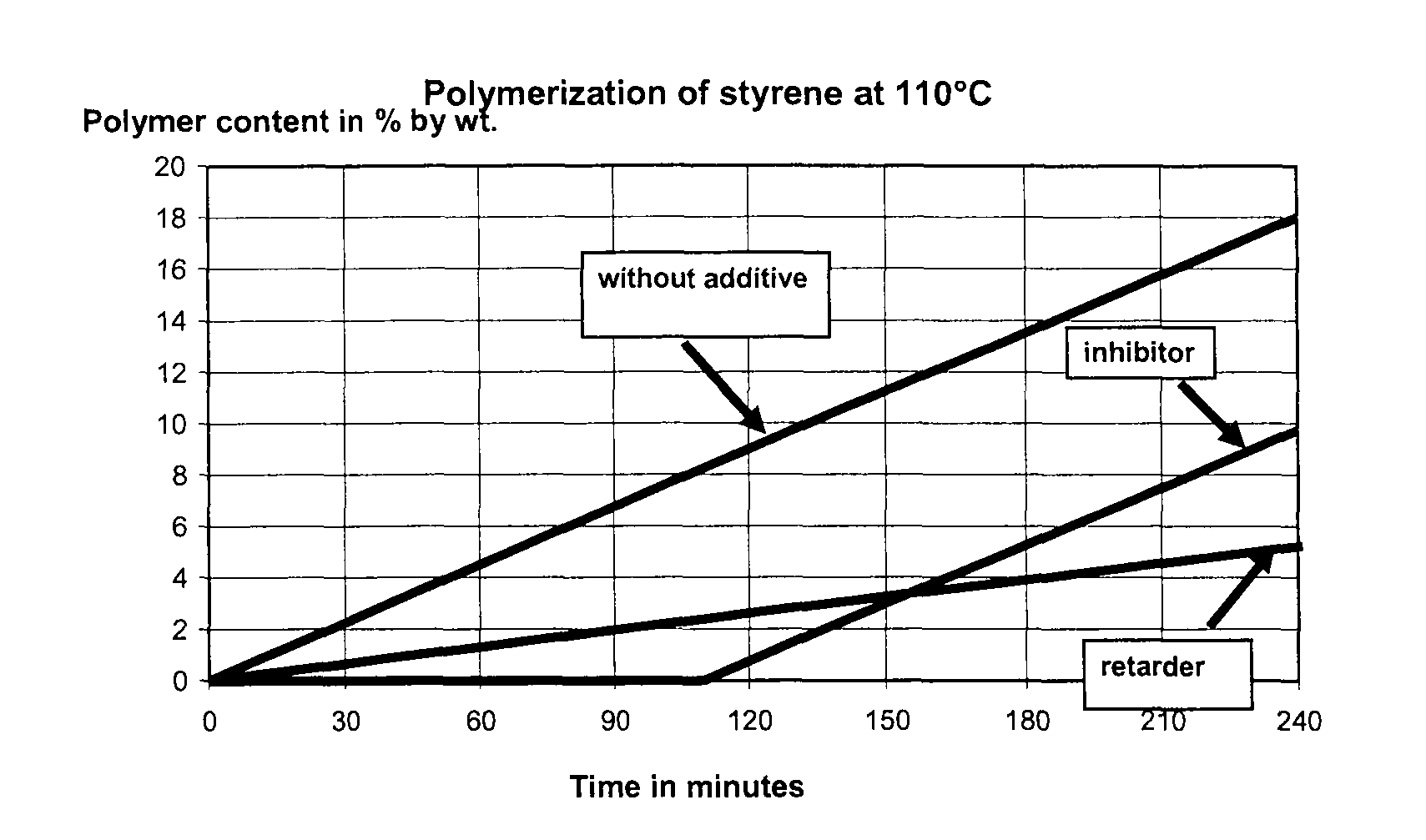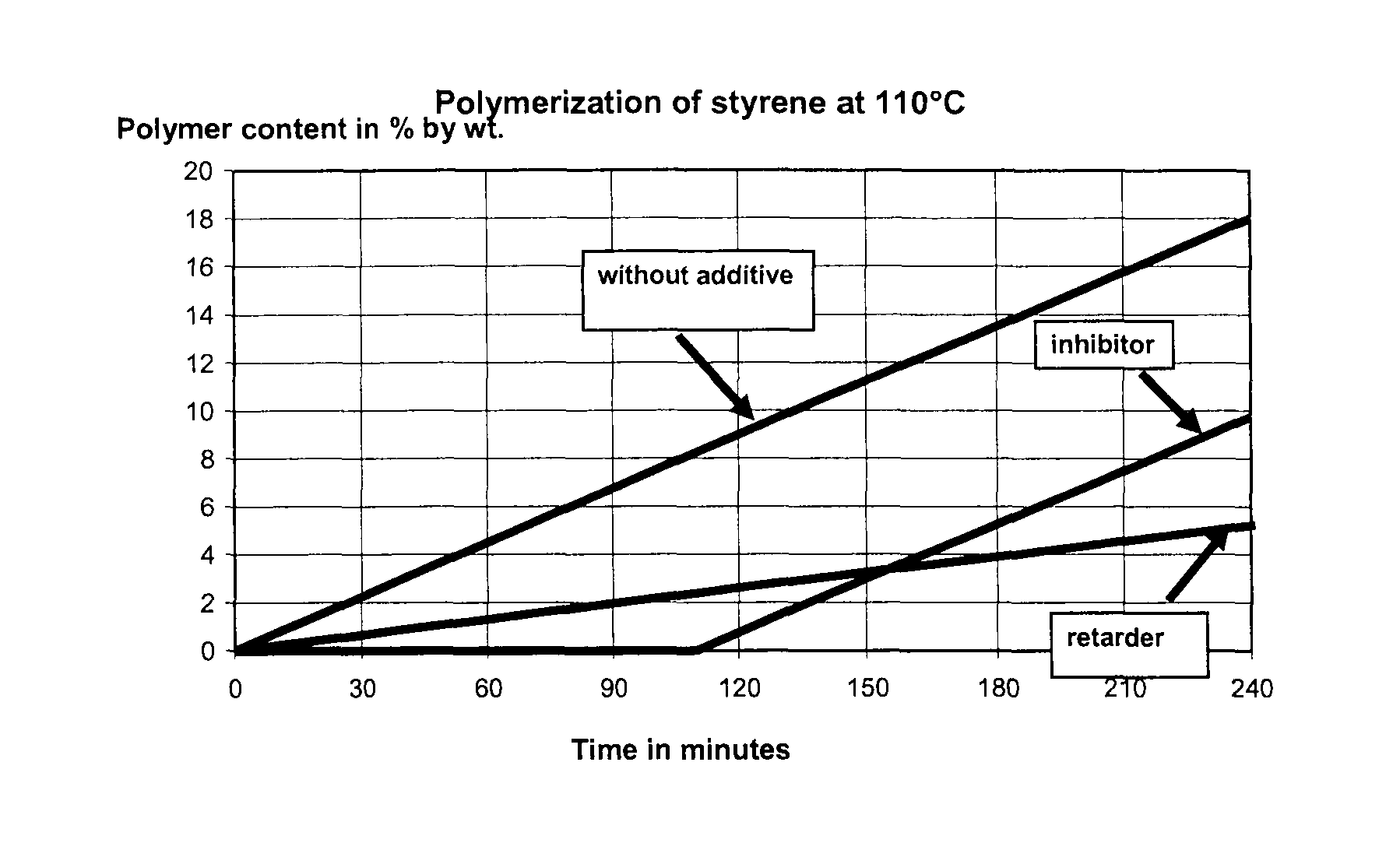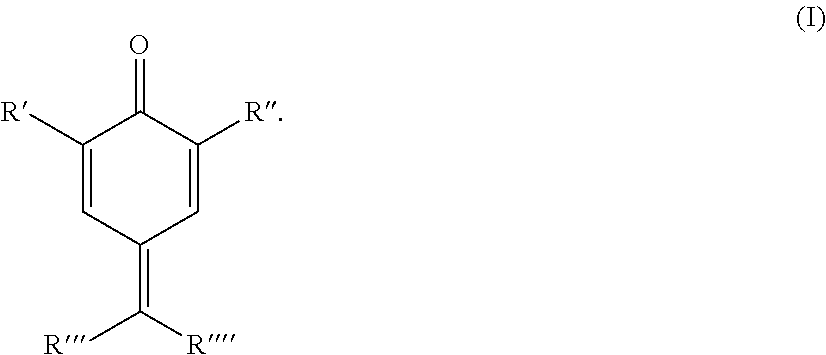Process for stabilizing olefinically unsaturated monomers
a technology of unsaturated olefins and monomers, applied in the direction of thermal non-catalytic cracking, thickeners, other chemical processes, etc., can solve the problems of unsuitable polymerization, risk of polymerization in all abovementioned monomers, and tendency to spontaneous polymerization, so as to reduce toxicity and reduce toxicity
- Summary
- Abstract
- Description
- Claims
- Application Information
AI Technical Summary
Benefits of technology
Problems solved by technology
Method used
Image
Examples
examples 1-10
[0146]Commercially available, stabilized styrene was freed of the tert-butyl-1,2-hydroxybenzene (TBC) stabilizer at a reduced pressure of 95 mbar and a bottom temperature of 75° C. in an inert nitrogen atmosphere. The test apparatus, which consisted of a four-neck flask equipped with a thermometer, a reflux condenser, a septum and a precision glass stirrer, was purged thoroughly with nitrogen in order to obtain an oxygen-free atmosphere. 300 g of the unstabilized styrene were added to the three-neck flask and admixed with 100 ppm of an additive according to Table 1. The additive was added either as a pure substance (examples 2-10) or as a solution (examples 10a-10c). The constant nitrogen supply through a glass frit into the styrene solution provided an inert nitrogen atmosphere over the entire test period. The styrene solution was stirred vigorously. At the start of the experiment, the flask was immersed into an oil bath preheated to 110° C. to such an extent that the stabilized st...
examples 11-18
[0148]Examples 11-18 were carried out analogously to examples 1 to 10, except that an additive mixture was added in examples 14 to 18. The results are shown in Table 2.
[0149]
TABLE 2Time until polymer content 2%Amount of additiveby weight was presentPolymer content afterExampleAdditive(in ppm (m / m))Mode of action of the additive(in min)180 minutes (in % by weight)11100inhibitor946.512100inhibitor926.5134-hydroxy-TEMPO5ppminhibitor2001.0DNBP95ppmretarder14oxo-TEMPO15ppminhibitor1951.5DNBP85ppmretarder154-hydroxy-TEMPO100ppminhibitor2180.5DTBMeOQM10ppmretarder164-hydroxy-TEMPO25ppminhibitor2580.1DTBMeOQM75ppmretarder17oxo-TEMPO60ppminhibitor2350.8DTBMeOQM40ppmretarder
examples 19-25
[0150]A saturated solution of in each case 250 mg of DTBMeOQM was made up in a solvent according to Table 3. Subsequently, the content of DTBMeOQM was determined by means of gas chromatography (GC). The solvent content was calculated in each case. These solutions were stored at room temperature for one week and then analyzed again by means of gas chromatography (GC). The results are shown in Table 3.
[0151]
TABLE 3Amount of DTBMeOQM(in area %)ExampleSolventStartafter 1 week19ethylbenzene10010020styrene10010021xylene1009922heptane999923n-butanol272024acetone1008225diethylene glycol monobutyl4422ether (DEGMBE)
[0152]The solvents and monomers used in the examples, such as styrene, ethylbenzene, methanol, xylene, heptane, n-butanol, acetone or diethylene glycol monobutyl ether (DEGMBE), and also the additives 4-hydroxy-TEMPO, oxo-TEMPO and DNBP were purchased from Sigma Aldrich or from Merck. The additive in example 3, in contrast, was purchased from Acros. The further additives used were ...
PUM
| Property | Measurement | Unit |
|---|---|---|
| carbon number | aaaaa | aaaaa |
| temperature | aaaaa | aaaaa |
| pressure | aaaaa | aaaaa |
Abstract
Description
Claims
Application Information
 Login to View More
Login to View More - R&D
- Intellectual Property
- Life Sciences
- Materials
- Tech Scout
- Unparalleled Data Quality
- Higher Quality Content
- 60% Fewer Hallucinations
Browse by: Latest US Patents, China's latest patents, Technical Efficacy Thesaurus, Application Domain, Technology Topic, Popular Technical Reports.
© 2025 PatSnap. All rights reserved.Legal|Privacy policy|Modern Slavery Act Transparency Statement|Sitemap|About US| Contact US: help@patsnap.com



